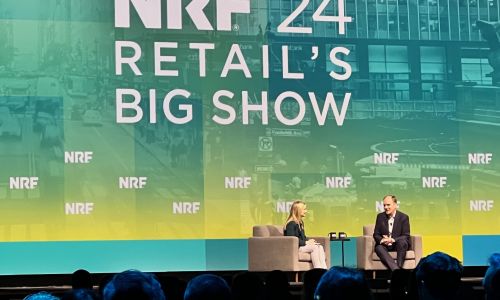Luxury retail is having a moment.
The industry has remained strong, even as worries about economic downturns have come and gone. And it seems poised for continued growth in the coming years. The luxury goods market is expected to grow more than 3% annually between now and 2028.
The shoppers driving this trend are increasingly Millennial and Gen Z. With more disposable income at their fingertips than previous generations, they’re buying luxury goods at a younger age than their predecessors. Millennials and Gen Zers are expected to account for 45% of personal luxury goods purchases in 2025, up from 32% in 2017.
Against this backdrop, it’s not surprising retailers are starting to pivot more toward luxury. Earlier this year Macy’s announced it will shutter 150 underperforming namesake stores by the end of the year and open 15 Bloomingdale’s stores and 30 Bluemercury luxury cosmetic locations.
As the luxury market grows and opportunities for retailers expand, brands need to take a thoughtful approach to how they’ll best service shoppers who expect a high-end, personalized, and bespoke customer experience (CX).
It’s never been more important to deliver memorable CX. Legacy luxury brands are finding their market position is under pressure, not only from traditional competitors but also from a growing number of new-age players – and customer service is emerging as a key competitive advantage .
But retailers often miss the mark by focusing on the wrong KPIs and metrics which, in turn, leads to optimizing the wrong channels. To drive customer loyalty and sales, you need to ensure the metrics you track and benchmarks you set are aligned to your broader CX strategy.
All channels are not equal
Just as their demographics are shifting, it’s time for high-end retailers to rethink how they’re measuring customer satisfaction. As the customer base widens and technological advances accelerate, the “old” way of measuring success no longer makes sense.
Different demographics want to shop and interact with retail brands via different channels. This is nothing new, but it’s especially important for luxury brands to keep in mind, since their customer base now likely spans various age groups.
Many retailers have an omnichannel CX approach – where customers can interact with brands via brick-and-mortar stores, websites, apps, and messaging – but too many make the mistake of measuring success (or failure) with one set of metrics.
Customer experiences are as different as the channels that deliver them. Customer satisfaction, for example, deviates significantly from in-person experiences to virtual interactions with a brand. Our research found a virtual retail experience has an average Net Promoter Score (NPS) of 56, compared with an NPS of 86 that an in-person experience brings.
There’s also a big difference in customer satisfaction when it comes to live retail encounters versus asynchronous ones. A live digital customer experience, like via voice or chat, has an average NPS of 52 while asynchronous experiences, like mail, have an average NPS of 30.
This customer satisfaction gap between live and asynchronous experiences is even more stark in the luxury retail industry. Luxury brands typically offer a highly personalized, concierge experience that can be hard to replicate in asynchronous channels.
Optimize channels to drive high-value outcomes
While some luxury retailers have been hesitant to adopt digital channels, hoping to instead steer customers toward the hyper-personalized feel of in-store shopping, changing consumer preferences have increasingly spurred many to explore ecommerce, apps, messaging, and other channels.
Embracing a more omnichannel approach can bring many benefits, but to drive high-value outcomes it’s important to remember that every channel is different. Customers have different expectations of interactions depending on what channel they’re using to shop or contact customer support. And they’ll likely turn to different channels to meet certain needs.
For these reasons, it’s crucial for brands to assess and measure each distinct channel based on its own nuances. Resist the urge to adopt a one-size-fits-all approach; there’s no one metric that will give a clear picture of how every channel is performing.
It’s also key to optimize each channel individually. Start by exploring your customer journey and identifying which channels are best at serving your top customer intents. Retailers collect a lot of data about customers; don’t let it go to waste. Use it to uncover why customers are contacting your brand in each channel.
Once you know why customers most commonly reach out via chat, for instance, you can optimize that channel to make interactions better and faster, improving the experience for your customers and your associates alike and driving gains in CSAT, NPS, and other metrics that matter.
Just because these CX efforts are rooted in data and technology doesn’t mean retailers have to sacrifice their personal touch. Infusing humanity into digital experiences is a great way for luxury retailers to maintain the bespoke level of service they take pride in while incorporating the ease modern shoppers want.
Offering video chats, providing personal concierge services via video, and allowing customers with sensitive inquiries to reach a human associate more quickly are just a few of the ways brands can humanize digital interactions.
Focus on the right KPIs
To deliver the best experiences to customers, brands need to dive deeply into their customer journey and understand where pain points are. Our research found the most common pain points for luxury retail customers are unsatisfactory customer support, returns and refunds, and online ordering.
Resist the urge to get hung up on certain KPIs, like NPS, and instead step back and take a more holistic view of how to remove friction for customers. What points in their journey with your brand frustrate them? What delights them? Where are there opportunities to make adjustments that improve CX and grow revenue?
Don’t try to shoehorn your CX efforts to generate a certain type of KPI result you think you need. Instead, take the time to really learn what is important to your customers, with tools like conversation intelligence and data analytics. Then determine the best way to measure your success.
The best metrics may not be the KPIs you’ve traditionally turned to (and that’s OK).
A new perspective drives results
When a luxury retail brand that started more than 100 years ago worried about its NPS, we helped it examine its CX and customer journey to see if its NPS number told the whole story. It didn’t. By focusing largely on this one metric, the company was getting a narrow and skewed view of customer satisfaction and missing out on key insights.
We asked the company: what does a one-point NPS gain translate to in terms of revenue growth? It was something they’d never considered before.
As we examined that question, by diving deeply into their data, we found NPS wasn’t the right metric to gauge whether the brand was successfully optimizing its CX. Other metrics – such as customer effort score, product engagement score, and customer health score – were much more meaningful.
Prioritizing metrics like these marked a culture shift at the company, but uncovered a wealth of actionable insights that made the brand’s CX more efficient and improved customer satisfaction.
Embrace the retail CX evolution
It can be difficult for luxury brands to rethink how they serve their customers and measure success, especially legacy brands that have been in business for decades. But shifting demographics, heightened consumer expectations, and growing competition in the market warrant taking a new look at traditional strategies.
With the right tools and people in place (and expert help if you lack the knowledge in-house), brands can deliver the type of personalized, concierge experiences luxury shoppers expect, even in an increasingly digital era. And by focusing on the right channels and metrics, retailers will become more efficient, cut costs, and grow customer satisfaction and loyalty.






